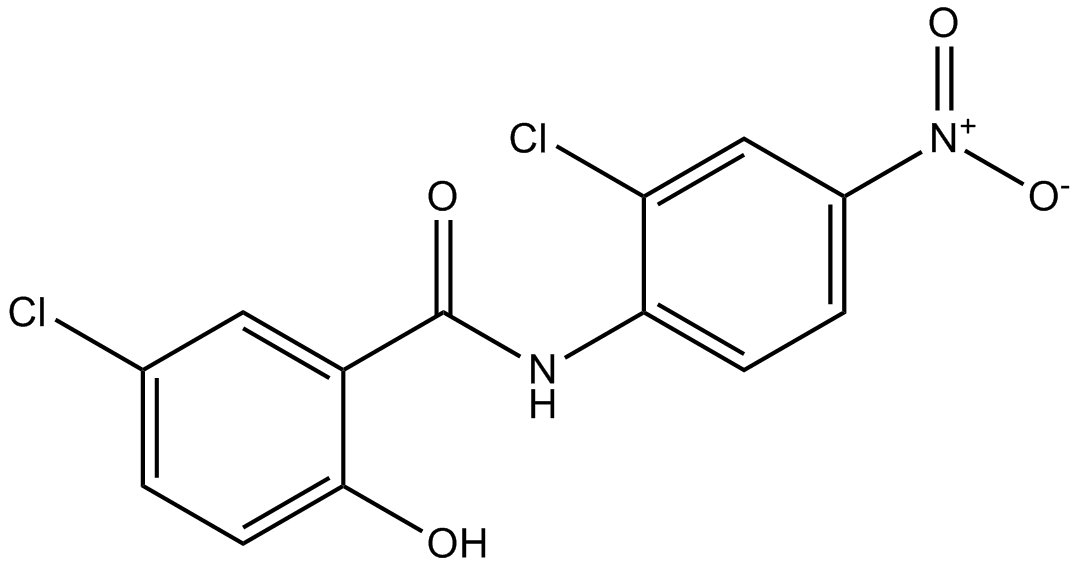Niclosamide (Synonyms: NSC 178296) |
| Catalog No.GC13586 |
Inhibitor of the STAT3 signaling pathway
Products are for research use only. Not for human use. We do not sell to patients.

Cas No.: 50-65-7
Sample solution is provided at 25 µL, 10mM.
Niclosamide (BAY2353) is an orally bioavailable chlorinated salicylanilide, with anthelmintic and potential antineoplastic activity. Niclosamide (BAY2353) inhibits STAT3 with IC50 of 0.25 μM in HeLa cells and inhibits DNA replication in a cell-free assay.
Niclosamide is an inhibitor of STAT3, inhibiting STAT3-mediated luciferase reporter activity with an IC50 of 0.25 μM in HeLa cells. Niclosamide (1 μM) inhibits the EGF-induced nuclear translocation of STAT3 in Du145 cells. Niclosamide (< 2 μM) dose dependently inhibits the transcription of STAT3 downstream genes in Du145 cells. Niclosamide (< 10 μM) induces G0/G1 arrest and apoptosis of Du145 cancer cells in a dose dependent manner[1]. Niclosamide can block SARS-CoV replication at a micromolar concentration in Vero E6 cells infected with SARS-CoV[2]. Niclosamide (< 7.5 μM) promotes Frizzled1 endocytosis, downregulates Dishevelled-2 protein, and inhibits Wnt3A-stimulated beta-catenin stabilization and LEF/TCF reporter activity in U2OS cells[3]. Niclosamide inhibits the TNF-induced NF-κB reporter activity in a dose- and time-dependent manner in U2OS cells. Niclosamide (125 nM) inhibits NF-κB activation induced by p65, IKKα, IKKβ, IKKγ, and TAK1 in U2OS cells. Niclosamide (< 500 nM) completely block the time- and dose-dependent TNFα-induced alteration of the NF-κB-DNA complex in HL-60 cells. Niclosamide (< 10 nM) inhibits constitutive NF-κB activation in U266 cells. Niclosamide inhibits TNF-induced degradation of IκBα and relocation of p65 in a dose- and time-dependent manner in HL-60, Molm13, or AML primary cells. Niclosamide (500 nM) causes decrease in TNF-induced NF-κB-dependent gene products involved in cell survival in HL-60 cells. Niclosamide also inhibits the growth and induces robust apoptosis of AML cells associated with decreased Mcl-1 and XIAP levels and increased intracellular ROS levels[4].
Niclosamide (40 mg/kg/d, i.p.) suppresses the growth of xenografted AML cells in nude mice bearing HL-60 xenograft tumors[4].
Reference:
[1]. Ren, X., et al., Identification of niclosamide as a new small-molecule inhibitor of the STAT3 signaling pathway. ACS Medicinal Chemistry Letters, 2010. 1(9): p. 454-459.
[2]. Wu CJ, et al. Inhibition of severe acute respiratory syndrome coronavirus replication by niclosamide. Antimicrob Agents Chemother. 2004 Jul;48(7):2693-6.
[3]. Chen, M., et al., The anti-helminthic niclosamide inhibits Wnt/Frizzled1 signaling. Biochemistry, 2009. 48(43): p. 10267-74.
[4]. Jin, Y., et al. Antineoplastic mechanisms of niclosamide in acute myelogenous leukemia stem cells: inactivation of the NF-kappaB pathway and generation of reactive oxygen species. Cancer Res, 2010. 70(6): p. 2516-27.
Average Rating: 5 (Based on Reviews and 15 reference(s) in Google Scholar.)
GLPBIO products are for RESEARCH USE ONLY. Please make sure your review or question is research based.
Required fields are marked with *




















